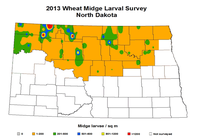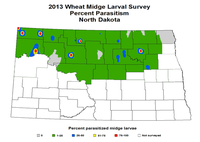Scout for Wheat Midge Hot Spots
(Click an image below to view a high-resolution image that can be downloaded)
Scout for Wheat Midge Hot Spots
Soil samples in North Dakota indicate increasing levels of overwintering wheat midge larvae (cocoons) in localized areas for the 2014 season, according to Janet Knodel, North Dakota State University Extension Service entomologist.
“Twenty one percent of the soil samples statewide are moderate to high risk for wheat midge infestation, so scouting is necessary to determine if fields are above economic thresholds and warranted an insecticide treatment to control wheat midge in 2014,” says Knodel.
A total of 189 soil samples were collected from 21 counties to estimate the regional risk for wheat midge. The distribution of wheat midge in the 2014 forecast map is based on unparasitized cocoons found in the soil samples collected in the fall of 2013.
""The high-risk pocket of 800 to greater than 1,200 midge larvae per square meter are concentrated in some areas in the north-central region of North Dakota, which include Burke, Renville, Ward and Pierce counties,” Knodel says. “Areas with moderate risk of 501 to 800 midge larvae per square meter include some areas in Burke, Divide, Renville, Rolette and Williams counties.”
Wheat midge populations increased four times from last year and ranged from zero to 3,285 midge larvae per square meter, with an average of 140 larvae per square meter in 2013. In contrast, wheat midge populations ranged from zero to 786 midge larvae per square meter, with an average of 34 larvae per square meter in 2012.
“The increase in wheat midge populations may be attributed to the increase in soil moisture during spring into June, which favors wheat midge development,” Knodel says.
Conditions that favor midge development and outbreaks include high soil moisture in late June, which makes it easier for the wheat midge to emerge from its soil cocoons. Most of the northern counties had a late and wet spring, with precipitation amounts being 130 to 200 percent above normal.
In the remaining counties, 50 percent of the samples had one to 500 larvae per square meter (low risk) and 44 percent had zero larvae per square meter.
“Although these areas with one to 500 midge larvae per square meter are considered low risk, we still recommend field scouting for wheat midge in fields with low populations because localized environmental conditions can impact wheat midge development and increase population levels quickly,” Knodel says.
A degree day model is a good predictor of wheat midge emergence and can help time field scouting. It is available on the NDSU North Dakota Agricultural Weather Network website at http://ndawn.ndsu.nodak.edu/wheat-growing-degree-days.html.
For field scouting, examine wheat heads at night when the temperature is greater than 59 F and the winds are calm (less than 6 mph). Scouting should be done during the heading to early flowering crop stages. Plants are susceptible as the head emerges from the boot.
The orange adult midge can be seen laying eggs on the wheat heads. The economic thresholds are when one or more midge are observed for every four or five heads on hard red spring wheat or when one or more midge are observed for every seven or eight heads on durum wheat.
“The critical time to spray is from late heading to early flowering,” Knodel says. “If wheat scab is a problem due to wet conditions during flowering, most insecticides labeled for wheat midge control can be tank-mixed with a fungicide.”
There’s an important biological control agent in fields that works for wheat producers by killing wheat midge larvae. It’s the parasitic wasp called Macroglenes penetrans.
“It plays an important role in keeping wheat midge controlled naturally during most years,” Knodel says. “The average parasitism rate was 7.6 percent in 2013 and similar to the 2012 level at 7 percent. In 2010 and 2011, parasitism rates were higher at 19 percent and 17 percent, respectively.”
Parasitism rates ranged from zero to 100 percent across the state, with the higher rates occurring in areas where midge populations have been high during the past year. The parasitic wasp and wheat midge populations are cyclical. Seventy-nine percent of the larval cocoons had zero parasitism in 2013. The low parasitism rate of 2013 is probably due to the low populations of wheat midge observed in 2013.
“We need to continue to conserve parasitic wasp populations when possible by spraying insecticides only when wheat midge populations are at economic threshold levels, and avoiding any late insecticide applications to minimize the negative impacts on the parasitic wasps that are active at that time,"" Knodel says.
The soil samples were collected by NDSU Extension Service agents in the fall of 2013.
The wheat midge survey is supported by the North Dakota Wheat Commission.
NDSU Agriculture Communication – March 7, 2014
| Source: | Janet Knodel, (701) 231-7915, janet.knodel@ndsu.edu |
|---|---|
| Editor: | Rich Mattern, (701) 231-6136, richard.mattern@ndsu.edu |



